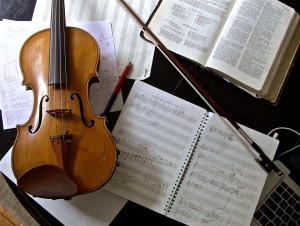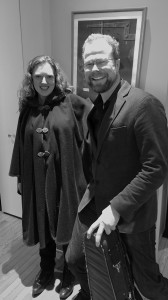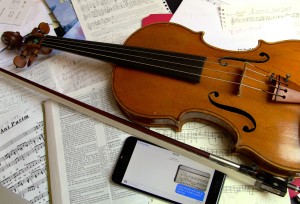I am thrilled to announce the world premiere of Personas, my five-movement solo sonata commissioned by violin virtuoso Rachel Barton Pine. Rachel premieres Personas at the Michigan Festival of Sacred Music on November 13th. In accordance with the festival’s sacred theme, Rachel has creatively programmed a recital inspired by Abrahamic traditions. The first half consists of Baroque works by Bach, Biber, and Corelli; in contrast, the second half features modern works by Yale Strom, Mohammed Fairouz, and myself. [Get your tickets here!]

Writing Personas was truly a labor of love, with a compositional process spanning a full two years. I challenged myself to realize the full potential of Rachel’s phenomenal musicianship and stylistic range. To that end, I drew from diverse musical reservoirs, including bluegrass, heavy metal, Hebrew prayer-modes and folk songs, bel canto operatic cadenzas, Paganiniana, and baroque counterpoint. Rachel is truly one of the few violinists who can navigate so many diverse styles and genres equally well.
In mid-October, I traveled to Chicago to meet with Rachel for an intensive 24-hour session of sharing, coaching, experimenting, and revising. Two days before my flight, I experienced a customary bout of “composer’s panic.” [“What if this piece really is awful? What if those chords don’t work? “Maybe I was thinking too much like a violist in this passage?”]. Silly me! In Rachel’s hands, every note easily surpassed my best hopes and expectations. One day of working together proved sufficient to refine Personas into its final form.

I hope to see you at the premiere or to share a recording soon! In the meanwhile, please enjoy a synopsis:
Personas
In August 2013, Rachel Barton Pine asked me to write “something of you, for me.” She was unaware that I was already in the process of adapting Nahum: An Apocalyptic Prophesy (a heavy metal instrumental for six-string electric viola) for her unplugged, standard violin.
After some excited discussion, we agreed that I would compose a five-movement sonata based upon Nahum and four other diverse and compelling Biblical personas. Because we both value inclusion, we agreed to make great women a priority.
The soloist embodies the characters’ personas. In some cases, the music parallels their actual messages or narratives. In others, the music projects an essence.
I composed the sonata in arch form: lighter, energetic outer movements flank dramatic, complex inner movements. In turn, the inner movements border an emotional, lyrical central movement. Personas commences and concludes with ecstatic rejoicing. Along the way, we encounter a prophesy of doom, a love story, and an intricate, suspenseful political thriller. Meet the personas:
Mary of Bethany:
Mary of Bethany is the sister of Martha and Lazarus, whom Jesus publicly raised from the dead. She is most remembered for sitting at Jesus’ feet listening instead of helping her sister prepare for a meal. She also anointed Jesus’ feet with her hair and priceless ointment, just days before his crucifixion. In this movement, the soloist projects the joy and reverie Mary finds in the presence of the divine and in knowing the power of resurrection.
Nahum:

A few generations after Jonah, the Hebrew prophet Nahum delivers another message of impending doom to the people of Nineveh, capitol city of the ancient Assyrian empire. In beautiful language, but graphic and unsettling terms, Nahum foretells an ultimate end to the Lord’s patience with a violent, imperialistic nation. The prophet predicts a siege, a flood, and the bloody and fiery annihilation of the Ninevites. Unusually sonic in his imagery, Nahum’s oracle describes galloping warhorses, clattering chariots, clashing swords, ravening lions, wailing refugees, whirlwinds, storms, and widespread panic. The prophesy was fulfilled to the letter when Nineveh fell to the combined forces of the Babylonians, Medes, and Scythians in 612 BC. Our soloist channels the essence of Nahum’s prophesy through a four- string acoustic violin.
Ruth:
If the Book of Ruth conveyed only the courtship of Ruth (a young, expatriate widow), and Boaz, (a righteous, aging, wealthy, but solitary, childless man), its tenderness would still make it one of the great love stories of the ancient world. However, the book transcends two-dimensional romance. Some of the most moving and famous passages depict the deeply loving and faithful relationship between Ruth and her bereaved mother-in-law, Naomi. (Without intervention, both faced an impoverished and heirless existence.)
In this movement, the soloist portrays the story’s emotional drama as related through Naomi and Ruth’s recurring conversations. We hear Naomi’s perspective in the more troubled, dissonant passages; Ruth melodiously speaks through the warmth and assurance of A flat major. Improvisatory cadenzas give voice to changing perspectives, potentialities, realities, and dialogues.
In this interpretation of Ruth, Boaz does not speak directly. Rather, the majestic, penultimate, climactic section belongs to the narrator. The narrator proclaims blessings, marriage, and consummation, then traces Boaz’s genealogy (and the couple’s subsequent progeny) through several generations to King David. The humble tale ends royally, but in this telling, Ruth gets the last word.
Esther:

Esther, Jewish queen of the Persian king, Ahasuerus (Xerxes I), remains one of the most celebrated heroines in Judaism. With shrewd guidance from her cousin and adoptive father Mordecai, Esther uses her beauty, diplomacy, and rhetorical skills to save her people from a genocidal plot instigated by Haman, an arrogant, powerful noble.
The music begins with a modal, improvisatory invocation, which unveils important musical motives and introduces a three-voice fugue. The soloist chronologically relates the entire drama from Esther’s soprano perspective, balanced by Mordecai’s tenor and bass.
Ever-changing harmonies and keys transform the fugue theme as the plot thickens. At times, the soloist becomes more omniscient or gives voice to the thoughts and plans of Haman and his wife, Zeresh. Intervening episodes freely develop fugue material, as well as melodies borrowed from the liturgy and folk songs of Purim1.
At the crux of the story, Esther reveals Haman’s treachery against Mordecai, who had previously foiled a plot to assassinate King Ahasuerus. The king is outraged. Haman appeals for mercy, but instead, he is hung on the gallows he had been preparing for Mordecai. To conclude, the Feast of Purim is decreed, and the triumphant celebration of Esther’s extraordinary heroism continues to this day. . .
John, Son of Zebedee:
John: Son of Zebedee; son of thunder; brother of James; fisherman; prophet; disciple whom Jesus loved; witness to the Transfiguration; author of one gospel, three epistles, and the apocalyptic Book of Revelation. Saint John.
John’s writings (and writings about him) reveal him to be strong, gentle, powerful, mystical, ambitious, self-effacing, personal, paternal, earthy, cosmic. As a whole, his words encompass the terrestrial, the celestial, the temporal, and the eternal.
To capture John’s visionary perspective, the musical variations combine pyrotechnic Paganiniana with grassy southern fiddling. In essence, the soloist exults in musical realms that simultaneously span the natural and the supernatural. (Yes, the variations are partly inspired by decades of improvising on the popular Gospel standard, “I’ll Fly Away!”)
Although each movement can be performed individually, combined, the movements of Personas create a broader context and message. In the hands of a virtuoso, John: Son of Zebedee makes a rousing encore on its own. However, as a culminating movement following Mary, Nahum, Ruth, and Esther, John drives home Personas’ central theme: divine hands transfigure ordinary lives.
David Wallace 19 August 2015 (Soli Deo Gloria)
1 Jewish holiday commemorating and celebrating the story of Esther.
Awestruck by the raw mixture of emotional depth and technical mastery of @DocWallaceMusic‘s “Personas” ably interpreted by @RBPviolinist
— Tim Macdonald (@tsmacdonald) November 10, 2015
This is going to be EPIC!
So well written. Your passion and depth of interest speak loudly through your words. I can only imagine how the music will carry your message with still greater force and imperative. I can’t wait to hear. Congratulations on the completion of a long and fruitful creative journey. I wonder what’s next in the career of David Wallace?